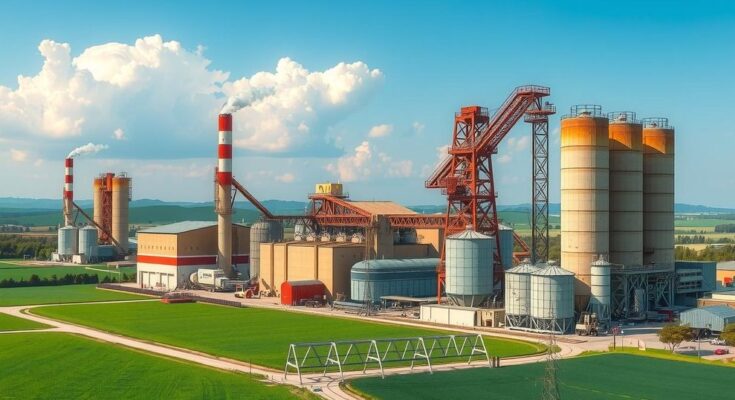Cameroon is increasing its cement production capacity to 12.7 million tons by 2025 with the construction of three new plants in Édéa. This expansion aims to meet local demand and enable exports, significantly enhancing competitiveness beyond the formerly monopolistic market. Current high prices of cement remain a concern due to import costs.
Cameroon plans to enhance its cement production capacity significantly by establishing three new cement plants in Édéa, situated in the Sanaga-Maritime department. This expansion is projected to increase the country’s total production capacity to 12.7 million tons by the conclusion of 2025, addressing local demand and facilitating exports to international markets.
The Minister of Industry, Mines, and Technological Development, Fuh Calistus Gentry, recently toured the new plants along with two nearby quarries. All three cement plants are being constructed by Chinese investors in Édéa, the capital of the department.
The first facility, Sino Africaine (Sinafcim), is currently being built and is anticipated to have an annual production capacity of 1 million tons. This plant has created employment for 200 workers, 90% of whom are Cameroonian, with the initial cement expected to be produced in April 2025.
The second plant, Central Africa Cement (CAC), has been operational for several months and boasts a production capacity of 1.5 million tons per year. It is currently employing 100 individuals, with plans to expand the workforce to 200.
The third facility, Yousheng Cement, is located on the banks of the Dibamba River near Douala and remains under construction. Upon completion, it will contribute an impressive annual capacity of 1.8 million tons.
With the completion of all three plants, Cameroon’s cement output will surge by an additional 4.3 million tons, elevating the total production capacity to 12.7 million tons by the end of 2025. This increase is expected to not only satisfy the national demand of 8 million tons but will also enhance Cameroon’s potential to export cement abroad.
The evolution of the cement industry in Cameroon reflects substantial growth. The establishment of these new plants will elevate the total number of cement production units in the nation to nine, a marked change since the end of the monopolistic reign of Cimencam, a Lafarge Holcim Maroc Afrique subsidiary, which controlled the market for 48 years with a production capacity of 2.3 million tons. New entrants such as Dangote Cement, Cimaf, Medcem, Mira Company, and Cimpor have intensified market competition since 2015.
Notwithstanding the rise in production capacity, cement prices remain elevated, with a standard 50 kg bag costing between 5,100 and 5,300 FCFA in major urban centers such as Douala and Yaoundé. Industry stakeholders and government officials attribute these high costs to the expenses involved in importing clinker, a vital component in cement manufacturing.
In conclusion, Cameroon is poised for a significant transformation in its cement industry, with the introduction of three new plants that will boost production capacity to 12.7 million tons by 2025. This development is expected to meet local demand and allow for export opportunities, thereby enhancing the competitiveness of the national cement market. However, the persistent high prices of cement due to importation costs pose challenges that need to be addressed for sustainable growth.
Original Source: www.businessincameroon.com




